+ データを開く
データを開く
- 基本情報
基本情報
| 登録情報 | データベース: PDB / ID: 5kp9 | ||||||||||||||||||||||||||||||||||||||||
|---|---|---|---|---|---|---|---|---|---|---|---|---|---|---|---|---|---|---|---|---|---|---|---|---|---|---|---|---|---|---|---|---|---|---|---|---|---|---|---|---|---|
| タイトル | Structure of Nanoparticle Released from Enveloped Protein Nanoparticle | ||||||||||||||||||||||||||||||||||||||||
 要素 要素 | EPN-01* キーワード キーワードSTRUCTURAL PROTEIN / protein design / icosahedral assemblies / cell transduction / enveloped viruses / virus assembly / enveloped protein / nanoparticle | 機能・相同性 |  機能・相同性情報 機能・相同性情報D-galactonate catabolic process / 2-dehydro-3-deoxy-6-phosphogalactonate aldolase activity / viral budding via host ESCRT complex / host multivesicular body / viral nucleocapsid / viral translational frameshifting / host cell nucleus / host cell plasma membrane / virion membrane / structural molecule activity ...D-galactonate catabolic process / 2-dehydro-3-deoxy-6-phosphogalactonate aldolase activity / viral budding via host ESCRT complex / host multivesicular body / viral nucleocapsid / viral translational frameshifting / host cell nucleus / host cell plasma membrane / virion membrane / structural molecule activity / RNA binding / zinc ion binding / identical protein binding / membrane 類似検索 - 分子機能 生物種 |   Thermotoga maritima (バクテリア) Thermotoga maritima (バクテリア) Human immunodeficiency virus type 1 group M subtype B (ヒト免疫不全ウイルス) Human immunodeficiency virus type 1 group M subtype B (ヒト免疫不全ウイルス)手法 | 電子顕微鏡法 / 単粒子再構成法 / クライオ電子顕微鏡法 / 解像度: 5.7 Å |  データ登録者 データ登録者Votteler, J. / Ogohara, C. / Yi, S. / Hsia, Y. / Natterman, U. / Belnap, D.M. / King, N.P. / Sundquist, W.I. | 資金援助 | |  ドイツ, ドイツ,  米国, 5件 米国, 5件
 引用 引用 ジャーナル: Nature / 年: 2016 ジャーナル: Nature / 年: 2016タイトル: Designed proteins induce the formation of nanocage-containing extracellular vesicles. 著者: Jörg Votteler / Cassandra Ogohara / Sue Yi / Yang Hsia / Una Nattermann / David M Belnap / Neil P King / Wesley I Sundquist /  要旨: Complex biological processes are often performed by self-organizing nanostructures comprising multiple classes of macromolecules, such as ribosomes (proteins and RNA) or enveloped viruses (proteins, ...Complex biological processes are often performed by self-organizing nanostructures comprising multiple classes of macromolecules, such as ribosomes (proteins and RNA) or enveloped viruses (proteins, nucleic acids and lipids). Approaches have been developed for designing self-assembling structures consisting of either nucleic acids or proteins, but strategies for engineering hybrid biological materials are only beginning to emerge. Here we describe the design of self-assembling protein nanocages that direct their own release from human cells inside small vesicles in a manner that resembles some viruses. We refer to these hybrid biomaterials as 'enveloped protein nanocages' (EPNs). Robust EPN biogenesis requires protein sequence elements that encode three distinct functions: membrane binding, self-assembly, and recruitment of the endosomal sorting complexes required for transport (ESCRT) machinery. A variety of synthetic proteins with these functional elements induce EPN biogenesis, highlighting the modularity and generality of the design strategy. Biochemical analyses and cryo-electron microscopy reveal that one design, EPN-01, comprises small (~100 nm) vesicles containing multiple protein nanocages that closely match the structure of the designed 60-subunit self-assembling scaffold. EPNs that incorporate the vesicular stomatitis viral glycoprotein can fuse with target cells and deliver their contents, thereby transferring cargoes from one cell to another. These results show how proteins can be programmed to direct the formation of hybrid biological materials that perform complex tasks, and establish EPNs as a class of designed, modular, genetically-encoded nanomaterials that can transfer molecules between cells. 履歴 |
|
- 構造の表示
構造の表示
| ムービー |
 ムービービューア ムービービューア |
|---|---|
| 構造ビューア | 分子:  Molmil Molmil Jmol/JSmol Jmol/JSmol |
- ダウンロードとリンク
ダウンロードとリンク
- ダウンロード
ダウンロード
| PDBx/mmCIF形式 |  5kp9.cif.gz 5kp9.cif.gz | 52.8 KB | 表示 |  PDBx/mmCIF形式 PDBx/mmCIF形式 |
|---|---|---|---|---|
| PDB形式 |  pdb5kp9.ent.gz pdb5kp9.ent.gz | 35 KB | 表示 |  PDB形式 PDB形式 |
| PDBx/mmJSON形式 |  5kp9.json.gz 5kp9.json.gz | ツリー表示 |  PDBx/mmJSON形式 PDBx/mmJSON形式 | |
| その他 |  その他のダウンロード その他のダウンロード |
-検証レポート
| 文書・要旨 |  5kp9_validation.pdf.gz 5kp9_validation.pdf.gz | 876.3 KB | 表示 |  wwPDB検証レポート wwPDB検証レポート |
|---|---|---|---|---|
| 文書・詳細版 |  5kp9_full_validation.pdf.gz 5kp9_full_validation.pdf.gz | 877.4 KB | 表示 | |
| XML形式データ |  5kp9_validation.xml.gz 5kp9_validation.xml.gz | 14 KB | 表示 | |
| CIF形式データ |  5kp9_validation.cif.gz 5kp9_validation.cif.gz | 18.8 KB | 表示 | |
| アーカイブディレクトリ |  https://data.pdbj.org/pub/pdb/validation_reports/kp/5kp9 https://data.pdbj.org/pub/pdb/validation_reports/kp/5kp9 ftp://data.pdbj.org/pub/pdb/validation_reports/kp/5kp9 ftp://data.pdbj.org/pub/pdb/validation_reports/kp/5kp9 | HTTPS FTP |
-関連構造データ
- リンク
リンク
- 集合体
集合体
| 登録構造単位 | 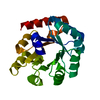
|
|---|---|
| 1 | x 60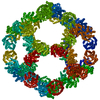
|
| 2 |
|
| 3 | x 5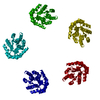
|
| 4 | x 6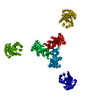
|
| 5 | 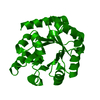
|
| 対称性 | 点対称性: (シェーンフリース記号: I (正20面体型対称)) |
- 要素
要素
| #1: タンパク質 | 分子量: 30304.920 Da / 分子数: 1 / 由来タイプ: 組換発現 由来: (組換発現)   Thermotoga maritima (バクテリア), (組換発現) Thermotoga maritima (バクテリア), (組換発現)  Human immunodeficiency virus type 1 group M subtype B (isolate BH10) (ヒト免疫不全ウイルス) Human immunodeficiency virus type 1 group M subtype B (isolate BH10) (ヒト免疫不全ウイルス)遺伝子: TM_0066, gag / 株: isolate BH10 / 細胞株 (発現宿主): HEK293T / 発現宿主:  Homo sapiens (ヒト) / 参照: UniProt: Q9WXS1, UniProt: P03347 Homo sapiens (ヒト) / 参照: UniProt: Q9WXS1, UniProt: P03347 |
|---|---|
| Has protein modification | Y |
-実験情報
-実験
| 実験 | 手法: 電子顕微鏡法 |
|---|---|
| EM実験 | 試料の集合状態: PARTICLE / 3次元再構成法: 単粒子再構成法 |
- 試料調製
試料調製
| 構成要素 | 名称: EPN-01* / タイプ: COMPLEX / Entity ID: all / 由来: RECOMBINANT |
|---|---|
| 由来(天然) | 生物種:   Thermotoga maritima (バクテリア) Thermotoga maritima (バクテリア) |
| 由来(組換発現) | 生物種:  Homo sapiens (ヒト) / 細胞: HEK293T / プラスミド: EPN-01* Homo sapiens (ヒト) / 細胞: HEK293T / プラスミド: EPN-01* |
| 緩衝液 | pH: 7.5 / 詳細: Phosphate-buffered saline |
| 試料 | 濃度: 0.2 mg/ml / 包埋: NO / シャドウイング: NO / 染色: NO / 凍結: YES 詳細: EPN nanoparticles released from vesicles by detergent treatment (0.75% CHAPS) |
| 試料支持 | グリッドの材料: COPPER / グリッドのタイプ: Quantifoil R2/2 |
| 急速凍結 | 装置: FEI VITROBOT MARK II / 凍結剤: ETHANE / 湿度: 80 % / 凍結前の試料温度: 277 K / 詳細: 11 second blot, 0 mm offset |
- 電子顕微鏡撮影
電子顕微鏡撮影
| 実験機器 | 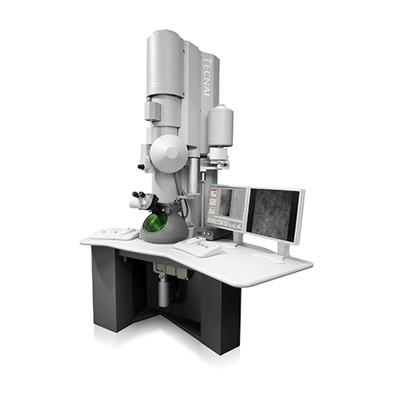 モデル: Tecnai F20 / 画像提供: FEI Company |
|---|---|
| 顕微鏡 | モデル: FEI TECNAI F20 |
| 電子銃 | 電子線源:  FIELD EMISSION GUN / 加速電圧: 200 kV / 照射モード: FLOOD BEAM FIELD EMISSION GUN / 加速電圧: 200 kV / 照射モード: FLOOD BEAM |
| 電子レンズ | モード: BRIGHT FIELD / 倍率(補正後): 41911 X / Calibrated defocus min: 700 nm / 最大 デフォーカス(補正後): 3300 nm / Cs: 2 mm / アライメント法: COMA FREE |
| 試料ホルダ | 凍結剤: NITROGEN 試料ホルダーモデル: GATAN 626 SINGLE TILT LIQUID NITROGEN CRYO TRANSFER HOLDER |
| 撮影 | 電子線照射量: 2 e/Å2 / 検出モード: SUPER-RESOLUTION フィルム・検出器のモデル: GATAN K2 SUMMIT (4k x 4k) 詳細: Electron dose at specimen was not recorded. |
| 画像スキャン | サンプリングサイズ: 2.5 µm / 横: 7420 / 縦: 7676 / 動画フレーム数/画像: 60 |
- 解析
解析
| EMソフトウェア |
| |||||||||||||||||||||||||||||||||||||||||||||
|---|---|---|---|---|---|---|---|---|---|---|---|---|---|---|---|---|---|---|---|---|---|---|---|---|---|---|---|---|---|---|---|---|---|---|---|---|---|---|---|---|---|---|---|---|---|---|
| CTF補正 | タイプ: PHASE FLIPPING AND AMPLITUDE CORRECTION | |||||||||||||||||||||||||||||||||||||||||||||
| 粒子像の選択 | 選択した粒子像数: 9177 | |||||||||||||||||||||||||||||||||||||||||||||
| 対称性 | 点対称性: I (正20面体型対称) | |||||||||||||||||||||||||||||||||||||||||||||
| 3次元再構成 | 解像度: 5.7 Å / 解像度の算出法: FSC 0.143 CUT-OFF / 粒子像の数: 8573 / アルゴリズム: FOURIER SPACE / クラス平均像の数: 10 / 対称性のタイプ: POINT | |||||||||||||||||||||||||||||||||||||||||||||
| 原子モデル構築 | プロトコル: RIGID BODY FIT |
 ムービー
ムービー コントローラー
コントローラー








 PDBj
PDBj



